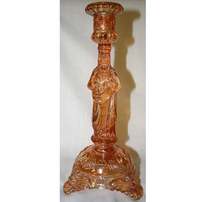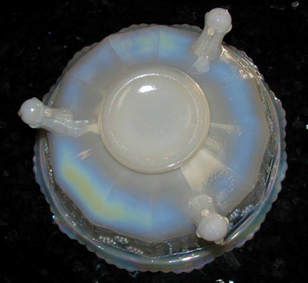Fake Carnival Glass
Copyright G & S Thistlewood
We have written several detailed articles about specific fakes - they are all available in the "Read more about fakes" links at the bottom of the page.
Although the most widely known and reported fakes to date are summarised on this page, there will be others and/or other colours. The best advice is education: books, newsletters and websites. Here, on Carnival Glass Worldwide, we will provide, and update, as full a list as possible. It's worth emphasising that a newly faked pattern, or a new version, or a different colour could be finding its way into the market. Check with other collectors or contact us on our very popular and active Facebook Group: Carnival Glass Network.
Intended to deceive
As with most sought-after antiques collectibles, Classic (old) Carnival Glass has been faked - contemporary items have been made intentionally to deceive and to be passed off as the genuine, original item. The whole purpose of a fake is to deceive a would-be purchaser/collector into thinking it is an old, genuine article.
Fakes are not the same thing as reissues and reproductions - in a nutshell, reissues and reproductions are contemporary pressings using original moulds, or possibly moulds that have been re-made or re-engineered. They were not usually made to deceive. However, there are exceptions to this - even though they were made by a bona-fide glass factory, and even shown in catalogues, once they get into the secondary market they have the potential to mislead the unwary collector. It is not unknown for the trademarks on reissues and reproductions to be removed - but some evidence will still remain, if you know what to look for.
It is impossible to provide fully comprehensive information about how to identify every single fake “out there”. Furthermore, it’s inadvisable to give what might appear to be absolute rules and details about fakes, as experience has shown that the makers of them can change the details of a piece: indeed many fakes are known to have different versions, as the faker appears to have tried to eradicate any mistaken features along the way!
All the above are FAKES. Left to right: Fenne Christ candlestick, Good Luck, Kangaroo, Stag and Holly.
To find out more about them, click on the images and links at the bottom of the page ("Read more about Fakes")
To find out more about them, click on the images and links at the bottom of the page ("Read more about Fakes")
The most widely known and reported fakes
Some fakes have been produced over several “generations” and they show small changes, tweaks and alterations over time in attempts to "perfect" an item by correcting any mistaken features along the way! We can't rule out other fakes and/or other colours.
Butterfly and Berry 3-footed Master bowl
These fake 3-footed master bowls were first reported in the 1980s. They are now known in the milky white opalescent-looking colour (which was advertised as "White Opal Iridescence") and in a , both as shown below, and also in blue and light pink. They are made from a new mould (not the Fenton original), with the interior pattern on the fake being more concentrated in the centre of the bowls.
In Classic (old) Carnival, Fenton made the Butterfly and Berry master berry bowls in various colours, including white, which is fairly rare. The one pictured above right, is courtesy of Seeck Auctions. The frosty white effect is markedly more subtle than the denser, milky white colour of the white fakes.
In Classic (old) Carnival, Fenton made the Butterfly and Berry master berry bowls in various colours, including white, which is fairly rare. The one pictured above right, is courtesy of Seeck Auctions. The frosty white effect is markedly more subtle than the denser, milky white colour of the white fakes.
|
In our NetworK ezine #61 we showed a paper label that was on a black amethyst fake "Butterfly and Berry" bowl. We have added it here on the right.
In our NetworK ezine #78 (November 2021) we showed an ad for A.A. Importing Co's imports of fake Butterfly and Berry bowls (and also Stag and Holly bowls) in both white and in purple Carnival. They were made in Korea. Here’s an easy and clear way to spot the Korean fake. We have to thank the late Frank M Fenton for this insight, as back in 1998, he studied the fakes and compared them to the Fenton pieces, and he pointed out this easy-to-spot difference to readily identify the fakes. |
Our article exploring the full and fascinating Story of the Butterfly and Berry pattern, from Classic to Revival Carnival, is here: The Enduring Butterfly and Berry. |
Detail of the central butterfly on
the fake, courtesy of Tony Meyer. |
Christ (aka Christus) and Maria: candlesticks (originals made by Brockwitz). Fakes made by Fenne by "cold application" of iridescence to old crystal sticks.
Good Luck: ruffled bowls (original made by Northwood). Fakes so far reported in marigold, green, a sort of turquoise, and possibly blue.
Grape and Cable: pie crust edge bowls (original made by Northwood). Fakes so far reported in marigold and green.
Peacocks: ruffled bowls (original made by Northwood). Fakes so far reported in marigold, green and blue.
These three faked Northwood patterns have achieved a certain notoriety, as most people have seen (or purchased) one of them. They first appeared in the UK in the 1980s and the general feeling is that they are Far Eastern in origin. They have undergone several changes over the years, as the makers have altered various details, making it harder to pinpoint features that clearly distinguish them as fakes. Some of the early fakes show oxidation of the iridescent surface.
Grape and Cable: hatpin holders (the originals were made by Northwood). Fakes come from China - we know because we saw a whole box full of them in an antique mall in the USA. The box was labelled up as being imported from China, and individual examples have also been seen sporting a Made in China paper label. Fakes are so far reported in red/red-amberina, green, blue and ice blue. The "first generation" fakes have very distinctive pointed flutes at the top that slope up quite steeply and look more like 'claws'. On the genuine article, the flutes around the top of the hatpin holder are curved over - they are much flatter and the separations between them are elegantly done. However, in January 2021, a new version of the fakes appeared, and the flutes/'claws' have been curved over, more in the style of the old original Northwood pieces.
Note also that there are false N marks on contemporary Grape and Cable covered butters and Grape Delight nut bowls. They began to appear in the mid-1970s in ice blue (Grape Delight), and in amber and ice blue (Grape and Cable butters), with what looked like a genuine N mark. They were in fact made by Mosser. Ironically, the false N mark was put on the Grape Delight nut bowl, possibly believing it to be a Northwood item, but in fact in Classic Carnival it was actually made by Dugan. Mosser later made the Grape and Cable butter in cobalt blue (without the false N mark). The base of the fake butter has a smooth scalloped edge, unlike the original Northwood which has a sawtooth edge.
Kangaroo: master bowl in the “Small Roo” (or “Doe”) version of the pattern (original made by Crown Crystal). These fakes first appeared in Australia in around 2006. They have been reported so far in marigold, amber, pink and light blue or crystal with pastel iridescence. The details are here.
Kingfisher: small 5" berry bowl (original made by Crown Crystal). Appearing in Australia around 2006, copied from original Crown Crystal pieces. At least four faked versions have been seen. They inferior to the quality of the originals, and there are several pattern differences. The easy way to tell the fakes is that they have mould seams - there are no mould seams on the original Kingfisher (they were made from a one piece mould have a ground base). The details are here.
Memphis: covered butters (original made by Northwood). So far only reported in purple (sometimes referred to as "black amethyst"). To our knowledge, no authenticated Northwood Memphis butter is known.
Stag and Holly: large ball-footed bowl (original made by Fenton). We believe the first of these fakes to hit the collectors market were imported into the USA in the early 1980s from Korea by AA Imports. We know they were made in Korea as several of them were found with labels attached. Fakes so far reported in black, deep purple, purple, blue, pearlized white (opal) and red. The fakes have been changed over time, but the stag's tongue is still the key way to identify them. The details are here, with thanks to Sharon A. Whitehead Smith for some very clear images of the fake stag.
In our NetworK ezine #78 (November 2021) we showed an ad for A.A. Importing Co's imports of fake Stag and Holly bowls (and also Butterfly and Berry bowls) in both white and in purple Carnival. They were made in Korea.
Hatpins: there are some Carnival “hatpins” that are actually buttons mounted on shafts (some are even new buttons).
Miscellaneous: there are supposedly rare “tumblers” that are actually pickle jars minus the lids (for example, Brockwitz Moonprint), and there are one-of-a-kind “rare” pieces with a pale, marigold-type sheen. They are not Carnival Glass - they are water ambered (in spring water, such as at Marlin in Texas) flint glass pieces. Read more here.
It's worth emphasising that a newly faked pattern, or a new version, or a different colour could be finding its way into the market. Check with other collectors or contact us on our very active Facebook Group if you’re unsure : Carnival Glass Network.
Read more about Fakes - click on any image






















